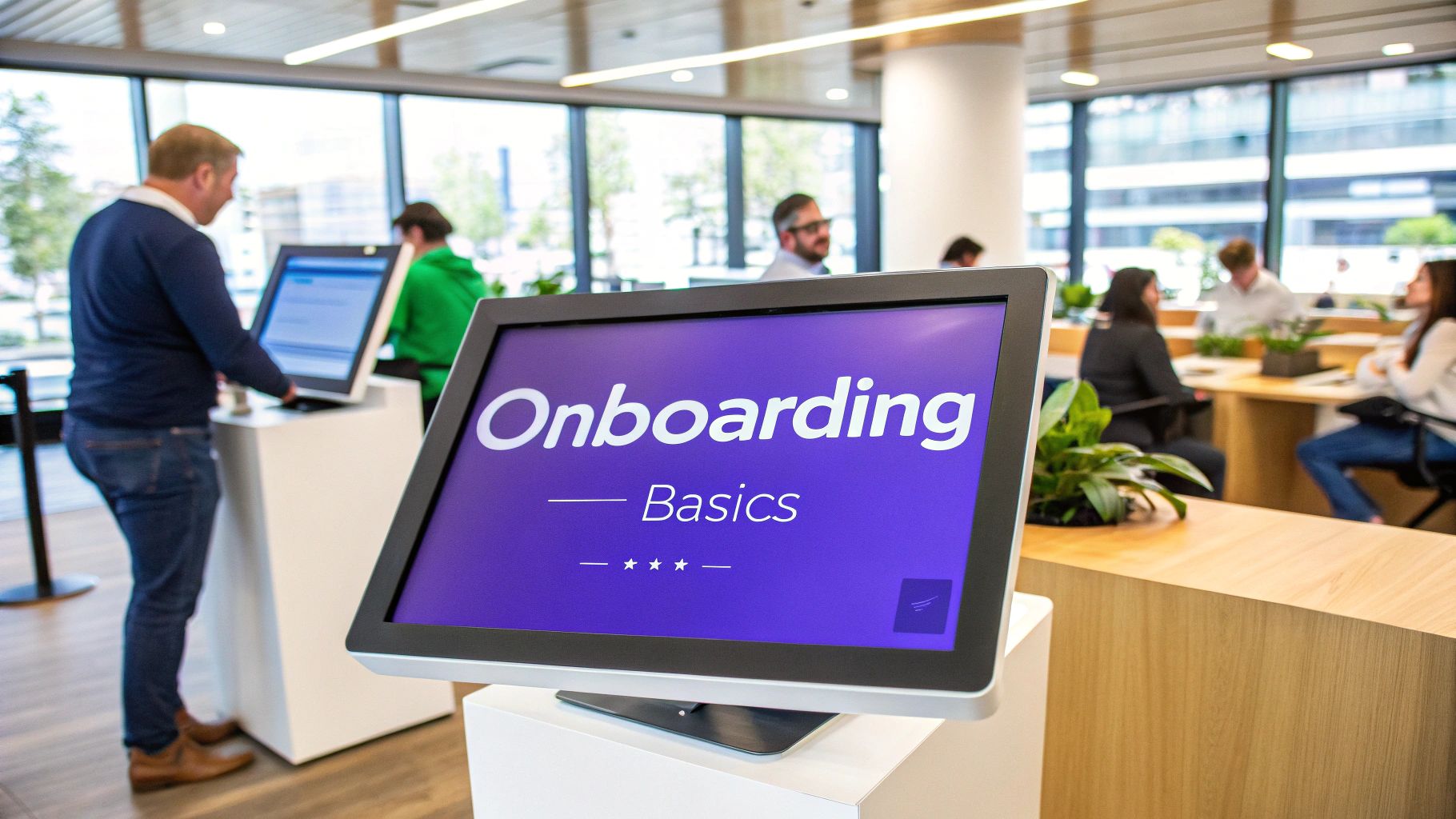The Evolution of Customer Onboarding Automation
Traditional customer onboarding often feels like a leaky bucket. Businesses pour resources into acquiring customers, only to lose them during a frustrating initial experience. Customer onboarding automation acts as a sealant, plugging those leaks and retaining valuable customers. This shift represents a fundamental change in how businesses view and nurture customer relationships.
This evolution stems from the need for efficiency and scalability. Manual onboarding, while potentially personalized, is difficult to scale as your customer base grows. It can also lack consistency, a critical component for creating a positive first impression.
This inconsistency can lead to customer frustration and, ultimately, churn. Think of building a house with inconsistent measurements and tools. The result? An unstable structure prone to collapse. Inconsistent onboarding is similar; it sets customers up for failure and weakens the foundation of your relationship with them.
Automated systems, however, offer a standardized, scalable approach. This ensures every new customer receives a consistent welcome and the guidance they need to be successful. This does not mean eliminating the human element.
Instead, automation frees up your customer success team. They can then focus on high-value interactions and build stronger relationships. Customer onboarding automation has significantly improved business efficiency and customer satisfaction. Automated processes can personalize the experience, streamline repetitive tasks, and ensure a standardized approach for every customer. This, in turn, increases customer satisfaction by reducing frustration and improving support, allowing customers to fully utilize the product.
Key Stages in Onboarding Automation Evolution

The progression of onboarding automation can be categorized into several stages:
- Manual Onboarding: This involves heavily manual processes, personalized but inconsistent and difficult to scale.
- Basic Automation: Simple automated emails and basic in-app messages replace some manual tasks.
- Segmented Automation: Onboarding is tailored for specific customer segments, delivering more relevant experiences.
- Intelligent Automation: Behavioral triggers and personalized pathways create dynamic, adaptive onboarding journeys.
Balancing Automation and the Human Touch
The ROI of Automated Onboarding: Beyond the Hype

Investing wisely in customer onboarding automation starts with understanding its return on investment (ROI). It's about seeing tangible results, not just following the latest trend. This means looking at the often-overlooked costs of ineffective onboarding and comparing them to the advantages of automation.
The Hidden Costs of Inefficient Onboarding
Inefficient onboarding can quietly drain your business resources. Let's explore some key areas where it takes its toll:
-
Increased Support Costs: When onboarding is unclear, your support team becomes the frontline, dealing with a surge in tickets and escalating costs.
-
Lower Product Adoption: A confusing onboarding experience can cause customers to abandon your product before they experience its benefits.
-
Damaged Brand Perception: First impressions matter. A negative onboarding experience can tarnish your brand's reputation.
-
Lost Revenue: Ultimately, these issues lead to lost revenue due to decreased customer lifetime value.
These hidden costs can be significant, impacting your bottom line and hindering growth.
These hidden costs can add up quickly. For example, effective onboarding can improve customer retention by up to 50%. This is essential considering that 74% of customers will leave if onboarding is too difficult. Additionally, companies lacking a solid onboarding process experience support costs that are 47% higher. In the SaaS world, poor onboarding contributes to 60% of post-signup churn. For more statistics on this, check out: Learn more about customer onboarding statistics. These figures highlight the vital role of efficient onboarding, especially in keeping new customers engaged.
Let's explore a table summarizing the key performance indicators (KPIs) impacted by onboarding automation:
Manual vs. Automated Onboarding: Key Performance Indicators This table compares critical business metrics between traditional manual onboarding processes and automated onboarding systems.
| Performance Indicator | Manual Onboarding | Automated Onboarding | Improvement Potential |
|---|---|---|---|
| Customer Retention Rate | Often low, potentially below 50% | Significantly higher, up to +50% improvement | Substantial, opportunity to retain more customers |
| Support Costs | High, potentially 47% higher than with automated systems | Lower due to reduced support tickets | Significant cost savings possible |
| Customer Churn (SaaS) | High, potentially 60% post-signup | Lower due to improved product adoption | Reduced churn and increased customer lifetime value |
| Time-to-Value | Longer due to manual processes | Faster due to automated guidance and support | Quicker realization of product value for customers |
| Customer Satisfaction | Lower due to potential frustration during onboarding | Higher due to streamlined and user-friendly experience | Enhanced customer experience and positive brand perception |
As shown in the table, automated onboarding offers significant potential for improvement across various KPIs, leading to better business outcomes. The impact on customer retention and support costs alone makes a strong case for automation.
Measuring the ROI of Automation
Smart companies look at both quantitative and qualitative factors when evaluating the ROI of customer onboarding automation.
-
Quantitative Gains: These include metrics like higher customer retention, faster time-to-value (how quickly customers benefit from your product), and lower customer acquisition costs.
-
Qualitative Improvements: These are less tangible but equally important, including increased customer satisfaction, more positive word-of-mouth referrals, and a stronger brand image. Interested in learning more about improving the customer onboarding process? Take a look at this resource: How to improve the customer onboarding process.
By closely monitoring these metrics, businesses can demonstrate the real impact of automation and gain support from key stakeholders. Even small businesses can benefit from effective customer onboarding automation. For more information, consider exploring: SEO Services for Small Business. Highlighting the positive effects of automation in these areas strengthens the argument for investment.
Building Blocks of Exceptional Onboarding Automation

Effective customer onboarding automation is more than just automated welcome emails. It's about crafting a structured, engaging experience that guides customers toward success. This involves understanding the key components and how they work together to foster long-term loyalty.
Personalized Onboarding Pathways
Generic onboarding often falls flat. Different customer segments have distinct needs and goals. Personalized onboarding pathways cater to this by tailoring the experience. This means providing relevant information and guidance based on specific customer characteristics like their industry, role, or company size.
For example, a Shopify store owner selling handcrafted goods through Tevello might need help setting up online courses. Another selling digital products might prioritize community building features. By segmenting and personalizing, you ensure relevance and avoid overwhelming customers.
Progressive Disclosure
Imagine teaching someone to drive by explaining every single button and function at once. It's overwhelming. Progressive disclosure in onboarding avoids this. Instead of bombarding new customers with everything immediately, it gradually reveals product features and functionality as they progress.
This prevents information overload and lets customers absorb key concepts at their own speed. As customers become more comfortable, new features are introduced, keeping them engaged without feeling overwhelmed.
Automated Milestone Celebrations and Check-ins
Celebrating small wins is key for motivation. Automated milestone celebrations acknowledge customer progress and reinforce positive behavior. This could be a congratulatory email after completing a key step or a personalized message recognizing achievements within the platform.
Automated check-ins also ensure customers stay on track. These could be scheduled emails or in-app messages with helpful tips, resources, or simply asking how things are going. These automated interactions nurture the customer relationship and offer proactive support, potentially reducing churn.
The role of automation in customer onboarding is increasingly critical. 55% of customers will stop using a product they don't understand, and 75% will abandon it within the first week if onboarding is difficult. 58% of customers find personalization essential to their onboarding experience. Automation helps address these challenges, improving efficiency and reducing human error, saving up to 498 hours annually per team member. Find more detailed statistics here. These automated processes personalize customer journeys, enhancing their experience and boosting engagement.
Navigating the Onboarding Automation Technology Landscape

Choosing the right customer onboarding automation tools can feel overwhelming. This guide helps you select the best technology for your business needs. We'll compare various solutions, from focused onboarding platforms to comprehensive customer success suites, empowering you to make informed choices.
Choosing the Right Tool for the Job
Understanding the different types of onboarding automation tools is the first step. This knowledge is essential for making a smart investment that helps you achieve your business goals.
-
Specialized Onboarding Platforms: These platforms concentrate solely on onboarding. They provide features like in-app guidance, checklists, and progress tracking, making them a solid choice for businesses aiming to enhance the initial customer experience.
-
Customer Success Suites: These comprehensive platforms offer onboarding alongside other customer relationship management tools. They're ideal for businesses looking for a complete solution to manage the entire customer lifecycle. Tevello is one example. For Shopify store owners, it offers integrated course and community features that streamline the onboarding process for merchants and customers alike.
-
CRM Systems with Onboarding Capabilities: Some CRM systems offer basic onboarding features. This can be a budget-friendly choice if your CRM already handles most of your needs. However, these built-in solutions may not offer the specialized features of dedicated platforms.
To help you compare these options, here's a helpful table:
To help you evaluate potential solutions, the table below provides a quick overview of common onboarding automation tools.
Onboarding Automation Tool Comparison
Overview of different types of onboarding automation platforms and their capabilities.
| Tool Type | Key Features | Best For | Typical Price Range | Integration Capabilities |
|---|---|---|---|---|
| Specialized Onboarding Platforms | In-app guidance, checklists, progress tracking | Businesses focused on improving initial customer experience | Varies widely, often based on users or features | Often integrates with popular CRMs and marketing automation tools |
| Customer Success Suites | Onboarding, CRM, customer support, analytics | Businesses seeking a comprehensive customer management solution | Typically higher than specialized platforms, often subscription-based | Usually offers broad integrations across various business systems |
| CRM Systems with Onboarding Capabilities | Basic onboarding workflows, often limited customization | Businesses already using a CRM and needing simple onboarding features | Included in the CRM price, potentially lower cost | Limited to the CRM's existing integrations |
This table highlights the key distinctions between different onboarding automation tool categories. Specialized platforms excel at onboarding, while customer success suites offer broader functionality. Choosing the right type depends on your specific requirements and existing systems.
Key Questions to Ask Vendors
Asking vendors the right questions is crucial before selecting a platform. Thorough research saves you time, money, and potential headaches.
-
Integration Capabilities: How well does the tool integrate with your existing tech stack? Smooth data flow is vital for personalized onboarding experiences.
-
Scalability: Can the platform handle your future growth? Choose a solution that can adapt as your business evolves.
-
Pricing: Does the pricing model fit your budget and expected return on investment? Understand all costs, including setup and maintenance.
-
Customization Options: Can you personalize the onboarding journey to reflect your brand and target specific customer segments? Flexibility is essential for creating a truly impactful onboarding experience.
Essential Features and Red Flags
Certain features are must-haves, while others signal potential problems.
-
Essential Features: Look for features like personalized messaging, progress tracking, A/B testing, and robust analytics. These tools are fundamental for effective onboarding automation.
-
Red Flags: Be wary of vendors who make unrealistic promises, lack transparent pricing, or have limited integration options. These are often signs of future difficulties.
Calculating ROI and Integration
Understanding your return on investment (ROI) and integration strategy is essential for long-term success.
-
ROI Timelines: Realistic ROI expectations depend on your business model and implementation approach. Don't anticipate instant results. Focus on creating a sustainable onboarding process.
-
Integration Approaches: A phased rollout minimizes disruption. Begin with a pilot program and gradually expand the platform to your entire customer base. For Shopify businesses using Tevello, combining courses and communities into the onboarding process can significantly boost customer lifetime value. This is achieved by offering added value early in the customer relationship.
By carefully evaluating these factors, you can confidently choose an onboarding automation solution that brings real results to your business. This thoughtful process will help you maximize your investment and ensure a smooth transition.
Implementation Blueprint: From Planning to Launch
Turning the concept of customer onboarding automation into a reality requires a solid plan. This blueprint provides a step-by-step guide to navigate the implementation process, ensuring a smooth experience for your team and your customers.
Phase 1: Preparation and Planning
Thorough preparation is crucial before starting implementation. This involves two important steps:
-
Process Mapping: Visualize your current onboarding workflow. This helps pinpoint bottlenecks and areas that would benefit from automation. It's like mapping a route before a road trip – you need to know your starting point and destination.
-
Stakeholder Alignment: Get buy-in from all relevant departments. This ensures everyone is aware of the goals and advantages of automation, fostering a collaborative environment.
Phase 2: Auditing Your Current Onboarding
Next, conduct a comprehensive audit of your existing onboarding process. This includes:
-
Customer Feedback: Collect feedback from current customers. This offers invaluable insights into their pain points and what aspects they find most valuable.
-
Data Analysis: Examine existing onboarding data. This can uncover trends and patterns, such as where customers abandon the process or encounter difficulties.
-
Identifying Quick Wins: Prioritize automating high-impact areas first. These early successes showcase the value of automation, building momentum for further implementation.
Phase 3: Phased Implementation
A phased approach minimizes disruptions and enables adjustments along the way. This generally involves:
-
Pilot Program: Test the automated onboarding with a small group of customers. This allows you to gather feedback and address any potential issues before a full launch.
-
Iterative Improvement: Refine the automated process based on the pilot program feedback. This iterative approach guarantees continuous improvement.
-
Full-Scale Deployment: Once you’re confident in the automated process, roll it out to all your customers.
Phase 4: Addressing Challenges and Roadblocks
Implementation isn't always straightforward. Anticipating potential challenges is essential for effective navigation.
-
Resistance to Change: Some team members may be hesitant about adopting automation. Address their concerns and emphasize the benefits, such as freeing up their time for more strategic tasks.
-
Technical Issues: Integration problems or technical glitches can arise. Having a contingency plan in place, such as fallback procedures or dedicated technical support, minimizes disruptions.
-
Customer Adaptation: Some customers may prefer the previous onboarding process. Offer clear communication and support to facilitate their transition to the new automated system.
By following this blueprint and proactively addressing potential obstacles, you can successfully implement customer onboarding automation and realize its numerous benefits. These include improved customer retention, reduced support costs, and faster time-to-value. This strategic approach lays the foundation for long-term customer success and sustained business growth.
Measuring What Matters: Onboarding Automation Metrics
Effective customer onboarding automation hinges on measuring the right metrics. This goes beyond simply tracking sign-ups. It requires a comprehensive framework that captures both the efficiency of your automated systems and their impact on the customer experience. This section explores building that framework using leading indicators and lagging outcomes.
Leading Indicators: Early Warning Signs
Leading indicators provide insights into potential issues before they escalate into major problems. They are early warning signals, allowing you to adjust and optimize your onboarding process.
-
Completion Rates for Each Onboarding Step: Tracking individual step completion rates reveals bottlenecks. For example, if many users abandon the process at a specific point, it indicates a need for improvement in that area.
-
Time Spent on Each Step: Analyzing the time users spend on each step adds context. Excessive time spent on a simple task suggests confusion or friction.
-
Support Ticket Volume Related to Onboarding: A surge in onboarding-related support tickets signals problems with clarity or usability. This metric highlights where users need help, indicating areas for improvement in automated guidance.
These leading indicators provide valuable real-time feedback on the effectiveness of your automated onboarding flows. Monitoring them allows you to proactively identify and address issues, optimizing the customer journey.
Lagging Outcomes: Business Impact Measures
While leading indicators focus on the process, lagging outcomes reveal the overall impact of your customer onboarding automation efforts on your business. These metrics demonstrate the long-term value.
-
Customer Retention Rate: This measures the percentage of customers who continue using your product or service over a defined period. Improved retention correlates directly with onboarding effectiveness in engaging and retaining customers. For more retention strategies, check out this article: 10 Ecommerce Customer Retention Strategies to Boost Sales
-
Time-to-Value: This measures how quickly new customers realize your product's benefits. A shorter time-to-value signifies a more efficient onboarding process guiding users toward their goals.
-
Customer Lifetime Value (CLTV): CLTV represents the total revenue generated by a customer throughout their relationship with your business. Effective onboarding contributes to higher CLTV by increasing retention and product adoption.
-
Customer Satisfaction (CSAT) Scores: Regularly measuring CSAT through surveys provides direct feedback on the onboarding experience. High scores indicate a positive journey, while low scores suggest areas needing improvement.
These lagging outcomes connect onboarding efforts to tangible business results. Tracking them demonstrates the value of customer onboarding automation and justifies ongoing investment in optimization.
Benchmarking and Testing
Establishing benchmarks is crucial for measuring progress and identifying areas for improvement. Base these benchmarks on your industry, business model, and growth stage. After planning, consider streamlining tasks with software to automate business processes. Avoid comparing your initial results to a mature company’s metrics.
A/B testing is essential for continuous optimization. Testing different onboarding flow versions identifies which variations yield the best results for completion rates, time spent, and ultimately, the lagging outcomes.
Creating Visibility Through Dashboards
Finally, create clear dashboards to visualize your onboarding metrics and share them with stakeholders. Connect onboarding improvements to key business outcomes like retention, expansion revenue, and customer advocacy. This fosters transparency and showcases the value of your customer onboarding automation initiatives.
Ready to transform your Shopify store? Explore Tevello and discover how automated onboarding can elevate your customer experience and drive business growth.




